|
|
|
German 6x4 KRUPP Protze - Tamiya 35104 |
|
|
|
|
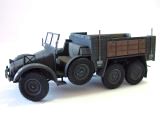 Specification : Chassis number : ? 123 units produced until February 1945 Crew : ? Weight : 2.6 tons Length : 4950 mm Width : 1950 mm Height : ? m Engine : KRUPP M304 3308cc air cooled engine Gearbox : ? Speed : ? km/h Range : ? km Armament : ? 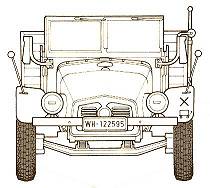 |
The
original policy of the Wehrmacht when providing itself with motor
transport was to use any suitable commercial types of trucks within
certain laid down requirements. In the light class a general specification
for a 6x4 chassis had been drawn up by the old Reichswehr in 1929, before
the army was reorganized and expanded under the Nazi regime. Several
famous vehicle makers in Germany produced designs in the light truck class
which conformed to the 6x4 requirement, amongst them Büssing-NAG,
Mercedes-Benz, and Magirus. However, by far the best known of these
trucks, because of its distinctive characteristics, was the Krupp L2H 43
and its successor, the L2H 143. This vehicle was popularly known as the
Boxer because it had an air cooled flat four square engine. This in turn
allowed a flat slopping engine cover of quite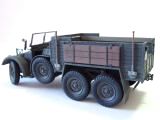 unmistakable shape which also gave excellent forward visibility and a low silhouette.
The Krupp Boxer was quite ubiquitous in application and the chassis
carried body work for a considerable number of different roles. Aside from
its air cooled engine, the Boxer also had an all independent suspension
system, differing from the conventional springing systems of other
six-wheelers in German service. The L2H 43 was in production from 1934-37
and was replaced in production by the L2H 143 which was externally almost
identical and differed only in mechanical and detail refinements.
unmistakable shape which also gave excellent forward visibility and a low silhouette.
The Krupp Boxer was quite ubiquitous in application and the chassis
carried body work for a considerable number of different roles. Aside from
its air cooled engine, the Boxer also had an all independent suspension
system, differing from the conventional springing systems of other
six-wheelers in German service. The L2H 43 was in production from 1934-37
and was replaced in production by the L2H 143 which was externally almost
identical and differed only in mechanical and detail refinements.From about 1940 a new class of light truck was introduced in either 4x4 or 4x2 forms, a 1.5 ton vehicle or 1500 as it was usually designated by the makers. This new type was part of the Schell Programm of standard types intended to cut down on the many different models previously in service and to standardize components. This type brought Krupp L2H 143 production to an end, but the Krupp Boxer was to be seen in German service right up to the end of the war. The standard truck version of the Krupp L2H 143 had a Krupp M304 3308cc air cooled engine which gave 52 bhp at 2500 rpm. It had a 2905mm wheel base and a weight of 2600 kg. Overall length was 4950mm, and width was 1950mm. There was also an armored version of this vehicle, mostly used for command purposes which was designated SdKfz. 247. In normal service form, however, the Boxer was fitted was a body suitable for its role and was designated according in the Wehrmacht ordnance inventory. The personnel and limber bodies were open topped with wood frame supports for canvas tilts, and canvas folding weather tops for the cab. The personnel carrier, used by infantry and other units, was designated Mannschaftskraftwagen (Kfz70) mit Fahrgestell des leichter gelndegängiger Lastkraftwagen(o). This long official title meant personnel carrier with special chassis of the light cross country truck (standard commercial). In practice the actual ordnance number Kfz 70, was used as a short description. Other versions with different bodies were Kfz81 (light AA truck), Kfz69 (Limber wagon or prime mover for light guns), and Kfz 83 (searchlight truck - two forms). To the German soldiers, the Krupp L2H was known as the Krupp Schnauzer. (From Tamiya Manual) |
|
|
|
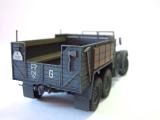 |
|
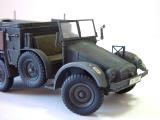 |
|
©
one35th - Last updated on :
Sunday, April 05, 2009 |
|